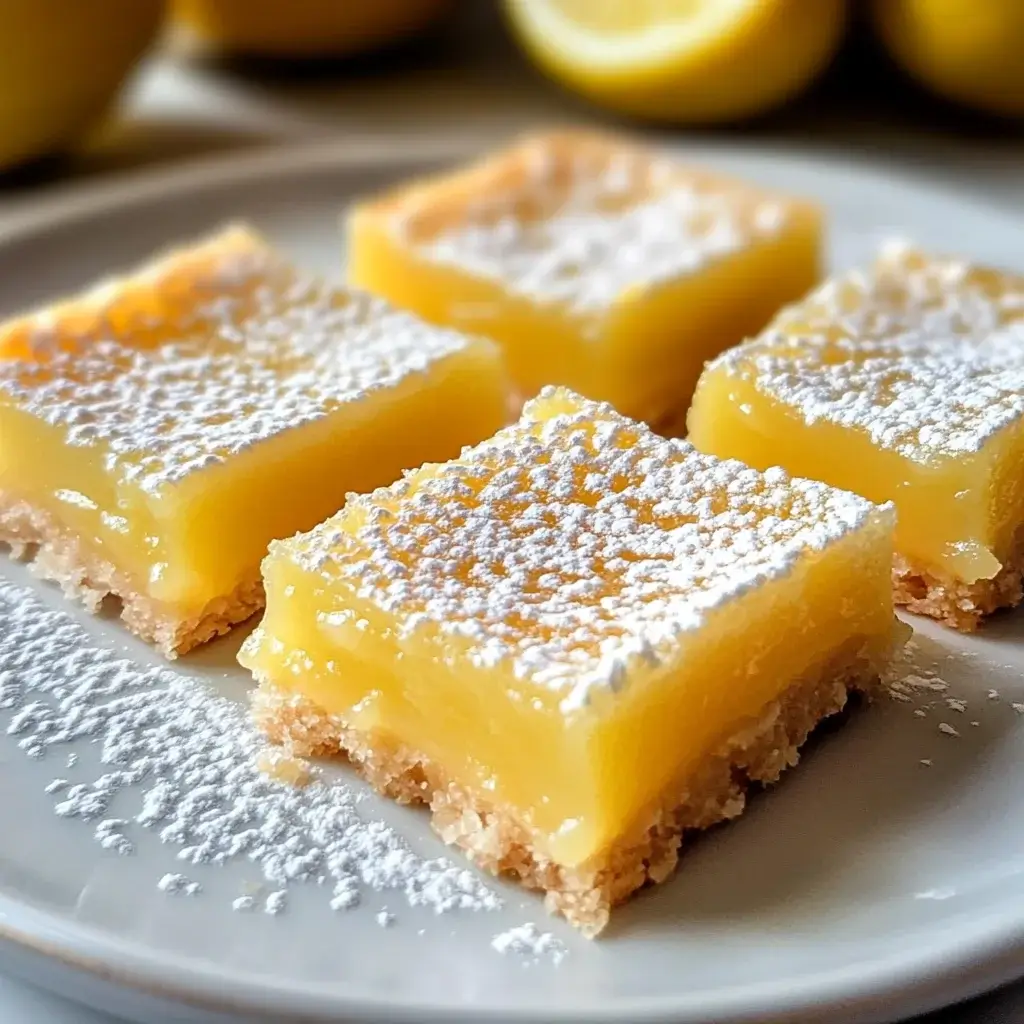The aroma of citrus baking in the oven is simply irresistible, isn’t it? For me, it instantly conjures up memories of sunny afternoons and the pure joy of a sweet treat. These Simple Homemade Lemon Bars? They’re more than just a recipe; they’re a little slice of sunshine on a plate. I whipped up a batch last weekend, and let me tell you, they were devoured within hours! My family, usually a tough crowd to please when it comes to desserts, were absolutely smitten. The perfect balance of tart lemon curd and sweet, buttery shortbread crust had everyone reaching for seconds (and maybe thirds!). The best part? They are incredibly easy to make, even for novice bakers. If you’re looking for a dessert that’s both impressive and effortlessly delicious, look no further. These lemon bars are guaranteed to brighten your day and become a new family favorite. Let’s get baking!
Ingredients for Simple Homemade Lemon Bars
Here’s what you’ll need to create these sunshine-filled lemon bars. We’ve broken it down into crust and filling ingredients for easy shopping and preparation.
- For the Crust:
- All-Purpose Flour: 2 cups, provides the structure for the shortbread crust, creating a tender yet slightly crumbly base.
- Powdered Sugar: ½ cup, adds sweetness and a delicate texture to the crust, ensuring it’s not overly sugary but perfectly balanced.
- Salt: ¼ teaspoon, enhances the flavors of the other ingredients and balances the sweetness.
- Unsalted Butter: 1 cup (2 sticks), cold and cut into cubes, essential for creating a flaky and buttery shortbread crust. Cold butter is key for the right texture.
- For the Lemon Filling:
- Granulated Sugar: 1 ½ cups, provides the primary sweetness for the lemon filling, balancing the tartness of the lemon juice.
- All-Purpose Flour: ¼ cup, helps to thicken the lemon filling, giving it a smooth and custard-like texture when baked.
- Large Eggs: 4, act as a binder and emulsifier, contributing to the richness and structure of the lemon curd filling.
- Lemon Juice: ⅔ cup, freshly squeezed is highly recommended for the brightest and most authentic lemon flavor. Bottled juice can be used in a pinch, but fresh is always superior.
- Lemon Zest: 2 tablespoons, adds a concentrated burst of lemon flavor and aroma, intensifying the citrus notes in the filling. Zest from about 2-3 lemons should be sufficient.
- Powdered Sugar (for dusting): Optional, for a beautiful finish and an extra touch of sweetness before serving.
Instructions: Baking Your Perfect Lemon Bars
Follow these step-by-step instructions to create delicious homemade lemon bars that are sure to impress. We’ll guide you through each stage, from making the crust to achieving that perfect tangy filling.
Step 1: Prepare the Crust
- Preheat Oven and Prepare Pan: Preheat your oven to 350°F (175°C). Line an 8×8 inch baking pan with parchment paper, leaving an overhang on the sides to easily lift out the finished lemon bars. This parchment paper sling is crucial for effortless removal and clean cutting later.
- Combine Dry Ingredients for Crust: In a medium bowl, whisk together the all-purpose flour, powdered sugar, and salt. Whisking ensures the ingredients are evenly distributed and prevents clumps of powdered sugar.
- Cut in Cold Butter: Add the cold, cubed unsalted butter to the dry ingredients. Using a pastry blender, your fingers, or a food processor, cut the butter into the flour mixture until it resembles coarse crumbs. You want to see small pieces of butter still visible, as these will create flakiness in the crust. If using your fingers, work quickly to keep the butter cold. If using a food processor, pulse in short bursts to avoid over-processing.
- Press Crust into Pan: Press the crumb mixture evenly into the bottom of the prepared baking pan. Use the bottom of a measuring cup or a flat-bottomed glass to firmly and evenly press the crust into the pan. This creates a compact and sturdy base for the lemon filling.
- Pre-bake the Crust: Bake the crust in the preheated oven for 15-20 minutes, or until it is lightly golden brown around the edges. Pre-baking the crust ensures it’s fully cooked and prevents a soggy bottom when the filling is added. Keep a close eye on it to prevent over-browning.
Step 2: Prepare the Lemon Filling
- Whisk Dry Ingredients for Filling: While the crust is baking, prepare the lemon filling. In a separate large bowl, whisk together the granulated sugar and all-purpose flour. This step is similar to the crust and ensures even distribution of the flour, preventing lumps in the filling.
- Whisk in Eggs: Add the eggs to the sugar and flour mixture and whisk until smooth and well combined. Ensure the eggs are fully incorporated to create a homogenous mixture.
- Add Lemon Juice and Zest: Pour in the fresh lemon juice and add the lemon zest. Whisk again until the filling is smooth and uniform. The mixture will be quite liquid at this stage, which is normal.
Step 3: Assemble and Bake Lemon Bars
- Pour Filling over Pre-baked Crust: Once the crust is pre-baked, carefully pour the lemon filling evenly over the hot crust. Pouring over a hot crust helps the filling to set properly and prevents the crust from becoming soggy.
- Bake Lemon Bars: Return the pan to the oven and bake for another 20-25 minutes, or until the filling is set and no longer jiggly in the center. The edges should be set and the center should have a slight jiggle, but not be liquid. Be careful not to overbake, as this can make the lemon filling tough.
- Cool Completely: Remove the lemon bars from the oven and let them cool completely in the pan on a wire rack. This is crucial for the filling to fully set and for the bars to be easy to cut. Cooling can take several hours at room temperature, or you can speed it up by refrigerating them.
- Chill (Optional but Recommended): For cleaner cuts and firmer texture, refrigerate the lemon bars for at least 2 hours, or preferably longer, after they have cooled to room temperature. Chilling makes them much easier to slice neatly.
Step 4: Cut and Serve
- Lift Lemon Bars from Pan: Once completely cooled and chilled (if desired), use the parchment paper overhang to lift the lemon bars out of the pan.
- Cut into Bars: Place the lemon bars on a cutting board and use a sharp knife to cut them into squares or bars. For clean cuts, you can wipe the knife clean between each cut, especially if the bars are slightly sticky.
- Dust with Powdered Sugar (Optional): If desired, dust the lemon bars generously with powdered sugar just before serving. This adds a touch of sweetness and elegance.
Nutrition Facts for Simple Homemade Lemon Bars
Here’s a general nutritional breakdown for one serving of these simple homemade lemon bars. Please note that these are estimates and can vary based on ingredient brands and specific measurements. This is based on a recipe divided into 16 servings.
- Serving Size: 1 bar (approximately 1/16th of the 8×8 inch pan)
- Calories: Approximately 220-250 calories per serving
- Total Fat: 10-12g
Disclaimer: Nutritional information is an estimate and should be used as a general guide. For precise nutritional values, use a nutrition calculator with specific ingredient brands.
Preparation Time for Simple Homemade Lemon Bars
These delightful lemon bars are surprisingly quick to prepare, making them perfect for both planned baking sessions and last-minute dessert cravings.
- Prep Time: Approximately 20-25 minutes. This includes measuring ingredients, making the crust dough, preparing the lemon filling, and pressing the crust into the pan. The process is straightforward and efficient, especially if you have your ingredients pre-measured.
- Bake Time: 35-45 minutes total. The crust bakes for 15-20 minutes, and then the lemon bars bake with the filling for another 20-25 minutes. Baking times can vary slightly depending on your oven, so keep an eye on the bars.
- Cooling Time: Minimum 2 hours at room temperature, ideally longer or chilled in the refrigerator for several hours for best texture and clean cuts. While the active prep and baking are relatively quick, the cooling time is essential for the bars to set properly and achieve their signature texture.
- Total Time (excluding chilling): Approximately 1 hour to 1 hour and 10 minutes. If you include chilling time, the total time extends but the active time remains short, making these bars a great make-ahead dessert.
How to Serve Your Lemon Bars
Lemon bars are incredibly versatile and can be enjoyed in many ways. Here are some serving suggestions to elevate your lemon bar experience:
- Classic Serving:
- Dust with Powdered Sugar: The most classic and simplest serving method. A generous dusting of powdered sugar adds a touch of sweetness and visual appeal.
- Plain: They are delicious all on their own! The perfect balance of tart and sweet makes them satisfying without any extra additions.
- Enhance with Freshness:
- Fresh Berries: Serve alongside a medley of fresh berries like raspberries, blueberries, or strawberries. The tartness of the lemon pairs beautifully with the sweetness of the berries.
- Whipped Cream or Crème Fraîche: A dollop of lightly sweetened whipped cream or crème fraîche adds a creamy coolness that complements the tangy lemon.
- Mint Sprig: Garnish with a fresh mint sprig for a touch of color and aromatic freshness.
- Dessert Pairings:
- Vanilla Ice Cream or Sorbet: Serve warm lemon bars (slightly warmed, not hot) with a scoop of vanilla ice cream or lemon sorbet for a delightful contrast in temperature and texture.
- Fruit Salad: Pair with a light and refreshing fruit salad for a balanced and summery dessert platter.
- Occasions to Serve:
- Afternoon Tea or Coffee: Lemon bars are perfect for afternoon tea or coffee breaks. Their bright flavor is a wonderful pick-me-up.
- Brunches and Luncheons: A delightful addition to brunch or luncheon spreads, adding a touch of elegance and sweetness.
- Parties and Gatherings: Easy to transport and serve, lemon bars are always a crowd-pleaser at parties, potlucks, and picnics.
- Holiday Desserts: While traditionally a spring/summer dessert, lemon bars can be a refreshing and lighter option during holiday dessert spreads, especially during warmer holidays.
Additional Tips for Perfect Lemon Bars
To ensure your lemon bars are a resounding success every time, here are some helpful tips and tricks:
- Use Freshly Squeezed Lemon Juice: Fresh lemon juice is key to achieving the best, brightest lemon flavor. Bottled lemon juice can taste slightly artificial and less vibrant. Squeezing your own lemons makes a noticeable difference in taste.
- Don’t Skimp on the Lemon Zest: Lemon zest is where a lot of the intense lemon flavor resides. Use a microplane or fine grater to zest the lemons, being careful to only zest the yellow part and avoid the bitter white pith.
- Cold Butter is Crucial for the Crust: For a flaky and tender shortbread crust, use very cold butter. Keep it refrigerated until just before you need to cut it into the flour mixture. Cold butter creates steam during baking, resulting in a light and flaky texture.
- Pre-bake the Crust Thoroughly: Pre-baking the crust is essential to prevent a soggy bottom. Bake it until it’s lightly golden brown around the edges, ensuring it’s fully cooked before adding the wet filling.
- Don’t Overbake the Filling: Overbaking the lemon filling can make it tough and rubbery. Bake until the edges are set and the center is just slightly jiggly. It will continue to set as it cools.
- Cool Completely Before Cutting: Patience is key! Let the lemon bars cool completely in the pan before attempting to cut them. This allows the filling to fully set and makes for cleaner, neater cuts. Chilling them in the refrigerator after cooling to room temperature is even better.
- Use Parchment Paper for Easy Removal: Lining your baking pan with parchment paper, leaving an overhang, makes it incredibly easy to lift the whole batch of lemon bars out of the pan for cutting. This prevents sticking and makes cleanup a breeze.
- Adjust Sweetness to Your Preference: If you prefer a tarter lemon bar, you can slightly reduce the granulated sugar in the filling. Conversely, if you like them sweeter, you can slightly increase the sugar, or dust generously with powdered sugar. Taste and adjust to find your perfect balance.
Frequently Asked Questions (FAQ) About Lemon Bars
Got questions about making lemon bars? We’ve got answers! Here are some frequently asked questions to help you bake with confidence.
Q1: Can I use bottled lemon juice instead of fresh?
A: While fresh lemon juice is highly recommended for the best flavor, you can use bottled lemon juice in a pinch. However, be aware that the flavor may not be as bright and vibrant as with fresh juice. If using bottled juice, opt for a high-quality brand without added preservatives if possible.
Q2: How do I store lemon bars?
A: Lemon bars should be stored in an airtight container in the refrigerator. They will keep well for up to 4-5 days. The cool temperature helps maintain their texture and prevents the lemon filling from becoming overly soft.
Q3: Can I freeze lemon bars?
A: Yes, lemon bars freeze beautifully! Cut them into bars, and then freeze them in a single layer on a baking sheet until solid. Once frozen, transfer them to an airtight container or freezer bag. They can be frozen for up to 2-3 months. Thaw in the refrigerator overnight or at room temperature for about an hour before serving.
Q4: My lemon bar filling is too runny. What did I do wrong?
A: Runny filling can be caused by not baking the bars long enough or by using too much liquid. Ensure you bake the bars until the edges are set and the center is just slightly jiggly. Also, double-check your lemon juice measurement. If you’re confident in your measurements and baking time, it’s possible your oven temperature is slightly off; consider using an oven thermometer.
Q5: My crust is tough. How can I prevent this?
A: A tough crust can result from overworking the dough or using too much liquid. When making the crust, mix until just combined. Avoid adding extra liquid unless absolutely necessary (the recipe should have sufficient moisture). Also, ensure you’re using cold butter and cutting it into the flour properly.
Q6: Can I make lemon bars ahead of time?
A: Absolutely! Lemon bars are a great make-ahead dessert. They are best made a day or two in advance, as chilling them in the refrigerator improves their texture and makes them easier to cut. This makes them perfect for parties and gatherings.
Q7: Can I add other flavors to my lemon bars?
A: Yes, you can! Consider adding a teaspoon of vanilla extract to the filling for a warmer flavor. You could also experiment with other citrus zests, like orange or lime, in addition to or instead of lemon zest for a different citrus twist. Some people also enjoy adding a sprinkle of poppy seeds to the crust or filling for texture and visual appeal.
Q8: Why are my lemon bars cracking on top?
A: Some cracking on the surface of lemon bars is normal and doesn’t affect the taste. However, excessive cracking can be a sign of overbaking or baking at too high a temperature. Make sure your oven temperature is accurate and avoid overbaking. Baking at a slightly lower temperature for a slightly longer time can sometimes help minimize cracking.
Enjoy baking these Simple Homemade Lemon Bars! They are a delightful treat that’s sure to bring a ray of sunshine to any occasion. Happy Baking!
Print
Simple Homemade Lemon Bars
Ingredients
Here’s what you’ll need to create these sunshine-filled lemon bars. We’ve broken it down into crust and filling ingredients for easy shopping and preparation.
- For the Crust:
- All-Purpose Flour: 2 cups, provides the structure for the shortbread crust, creating a tender yet slightly crumbly base.
- Powdered Sugar: ½ cup, adds sweetness and a delicate texture to the crust, ensuring it’s not overly sugary but perfectly balanced.
- Salt: ¼ teaspoon, enhances the flavors of the other ingredients and balances the sweetness.
- Unsalted Butter: 1 cup (2 sticks), cold and cut into cubes, essential for creating a flaky and buttery shortbread crust. Cold butter is key for the right texture.
- For the Lemon Filling:
- Granulated Sugar: 1 ½ cups, provides the primary sweetness for the lemon filling, balancing the tartness of the lemon juice.
- All-Purpose Flour: ¼ cup, helps to thicken the lemon filling, giving it a smooth and custard-like texture when baked.
- Large Eggs: 4, act as a binder and emulsifier, contributing to the richness and structure of the lemon curd filling.
- Lemon Juice: ⅔ cup, freshly squeezed is highly recommended for the brightest and most authentic lemon flavor. Bottled juice can be used in a pinch, but fresh is always superior.
- Lemon Zest: 2 tablespoons, adds a concentrated burst of lemon flavor and aroma, intensifying the citrus notes in the filling. Zest from about 2-3 lemons should be sufficient.
- Powdered Sugar (for dusting): Optional, for a beautiful finish and an extra touch of sweetness before serving.
Instructions
Follow these step-by-step instructions to create delicious homemade lemon bars that are sure to impress. We’ll guide you through each stage, from making the crust to achieving that perfect tangy filling.
Step 1: Prepare the Crust
- Preheat Oven and Prepare Pan: Preheat your oven to 350°F (175°C). Line an 8×8 inch baking pan with parchment paper, leaving an overhang on the sides to easily lift out the finished lemon bars. This parchment paper sling is crucial for effortless removal and clean cutting later.
- Combine Dry Ingredients for Crust: In a medium bowl, whisk together the all-purpose flour, powdered sugar, and salt. Whisking ensures the ingredients are evenly distributed and prevents clumps of powdered sugar.
- Cut in Cold Butter: Add the cold, cubed unsalted butter to the dry ingredients. Using a pastry blender, your fingers, or a food processor, cut the butter into the flour mixture until it resembles coarse crumbs. You want to see small pieces of butter still visible, as these will create flakiness in the crust. If using your fingers, work quickly to keep the butter cold. If using a food processor, pulse in short bursts to avoid over-processing.
- Press Crust into Pan: Press the crumb mixture evenly into the bottom of the prepared baking pan. Use the bottom of a measuring cup or a flat-bottomed glass to firmly and evenly press the crust into the pan. This creates a compact and sturdy base for the lemon filling.
- Pre-bake the Crust: Bake the crust in the preheated oven for 15-20 minutes, or until it is lightly golden brown around the edges. Pre-baking the crust ensures it’s fully cooked and prevents a soggy bottom when the filling is added. Keep a close eye on it to prevent over-browning.
Step 2: Prepare the Lemon Filling
- Whisk Dry Ingredients for Filling: While the crust is baking, prepare the lemon filling. In a separate large bowl, whisk together the granulated sugar and all-purpose flour. This step is similar to the crust and ensures even distribution of the flour, preventing lumps in the filling.
- Whisk in Eggs: Add the eggs to the sugar and flour mixture and whisk until smooth and well combined. Ensure the eggs are fully incorporated to create a homogenous mixture.
- Add Lemon Juice and Zest: Pour in the fresh lemon juice and add the lemon zest. Whisk again until the filling is smooth and uniform. The mixture will be quite liquid at this stage, which is normal.
Step 3: Assemble and Bake Lemon Bars
- Pour Filling over Pre-baked Crust: Once the crust is pre-baked, carefully pour the lemon filling evenly over the hot crust. Pouring over a hot crust helps the filling to set properly and prevents the crust from becoming soggy.
- Bake Lemon Bars: Return the pan to the oven and bake for another 20-25 minutes, or until the filling is set and no longer jiggly in the center. The edges should be set and the center should have a slight jiggle, but not be liquid. Be careful not to overbake, as this can make the lemon filling tough.
- Cool Completely: Remove the lemon bars from the oven and let them cool completely in the pan on a wire rack. This is crucial for the filling to fully set and for the bars to be easy to cut. Cooling can take several hours at room temperature, or you can speed it up by refrigerating them.
- Chill (Optional but Recommended): For cleaner cuts and firmer texture, refrigerate the lemon bars for at least 2 hours, or preferably longer, after they have cooled to room temperature. Chilling makes them much easier to slice neatly.
Step 4: Cut and Serve
- Lift Lemon Bars from Pan: Once completely cooled and chilled (if desired), use the parchment paper overhang to lift the lemon bars out of the pan.
- Cut into Bars: Place the lemon bars on a cutting board and use a sharp knife to cut them into squares or bars. For clean cuts, you can wipe the knife clean between each cut, especially if the bars are slightly sticky.
- Dust with Powdered Sugar (Optional): If desired, dust the lemon bars generously with powdered sugar just before serving. This adds a touch of sweetness and elegance.
Nutrition
- Serving Size: one normal portion
- Calories: 250
- Fat: 12g






